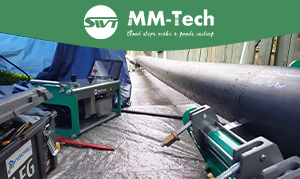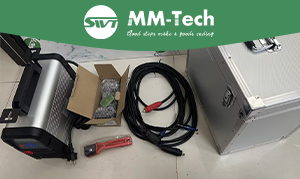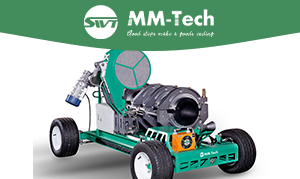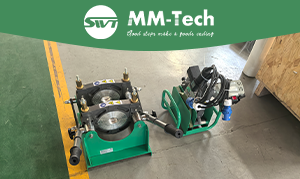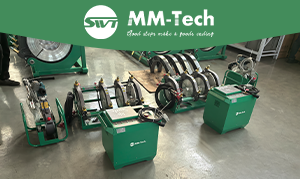To create strong and leak-free HDPE pipe joints in 2025, you need the right welding equipment. The most important types of welding equipment include:
Electrofusion welding machines for safe, easy-to-maintain joints
Socket fusion machines for smaller pipes
Specialized machines designed for various industrial applications
Choosing the right welding equipment improves weld quality, ensures worker safety, and prevents workplace hazards. High-quality welding equipment with advanced controls and safety features greatly supports every pipe installation job.
Key Takeaways
Use the correct welding equipment to make strong HDPE pipe joints. This helps stop leaks. Butt fusion machines are best for big pipes. Electrofusion and socket fusion work well for small pipes or tight spots. Digital controls and data logging make welds better. They also help you keep track of each step safely. Always get pipe ends ready with care. Follow safety rules to stay safe and avoid weak joints. Pick equipment that matches your project size. Think about your work area and power needs for the best results.
Welding Equipment for HDPE Pipes
Essential Tools and Machines
When you work with industrial HDPE pipes, you must use the right welding equipment. This helps you make strong and leak-proof joints. In 2025, you will use these main types of equipment:
Butt fusion welding machines: These machines scrape, heat, and join HDPE pipes. You can use them for both small and large pipes. They work with pipe sizes from 63mm to 1200mm. Butt fusion machines use exact temperature and pressure controls. This makes every joint strong and smooth. There are electric hydraulic and manual hydraulic models. Both types need steady power. You can use portable generators if you work far from power.
Electrofusion welding machines: These machines use special electrofusion fittings to join pipes. You get joints that are easy to keep up and very reliable. Electrofusion is good for water, mining, and industrial jobs. The machines use exact settings to control the fusion. This gives you the same results every time.
Socket fusion tools: You use these tools for smaller pipes. They heat the ends of the pipe and the socket. Then, they fuse them together. Socket fusion is used in plumbing and small industrial jobs.
Preparation tools: Before welding, you must get the pipes ready. Pipe cutting tools and debeaders help you cut and scrape the pipe ends. This step is needed for clean and strong joints.
Welding data loggers: These devices record welding settings. You can check your work and make sure you meet quality rules.
Power sources: Portable generators give power to your welding equipment. This is helpful when you work on-site.
Additional accessories: Pipe roller supports, squeeze tools, and test pumps help you move pipes and test your joints. These tools make your job easier and safer.
Tip: Always use the right preparation tools before welding. Clean and straight pipe ends help you get the best fusion.
Here is a quick look at the main equipment and what they do:
Equipment Category | Primary Functions | Application Contexts and Notes |
|---|---|---|
Butt Fusion Welding Machines | Scrape, heat, and join HDPE pipes for strong joints | Used in water, oil & gas, mining, and industrial jobs; works with pipes from 63mm to 1200mm |
Electrofusion Welding Machines | Heat and join HDPE pipes with electrofusion fittings | Good for many pipe sizes; used in water, mining, and industrial work |
Welding Data Loggers | Record welding settings for quality checks | Helps you follow industry rules |
Pipe Cutting Tools and Debeaders | Cut and scrape pipe ends | Needed for clean and neat pipe prep |
Power Sources (Portable Generators) | Give steady power to welding machines | Makes sure you can work where power is hard to get |
Additional Accessories | Pipe roller supports, squeeze tools, test pumps, saddle fusion machines, etc. | Make welding faster and help with many pipe fusion jobs |
MM-Tech Solutions Overview
You want welding equipment that is strong, simple to use, and lasts a long time. MM-Tech is a top brand for HDPE pipe welding. MM-Tech has many solutions for big projects.
MM-Tech Butt Fusion Machine: This machine lets you control temperature and pressure exactly. It has a Teflon-coated heating plate so pipes do not stick. You can weld pipes made from HDPE, PP, PPR, and PVDF. The machine works with pipes from 50mm to 1200mm. It has a digital control panel, a big pressure gauge, and a USB charging port. You can add a data logger to record welding settings for quality checks.
MM-Tech Electrofusion Welding Machine: This machine uses smart controls for steady voltage and timing. It works well in tough places and with many pipe sizes. The bright LCD screen helps you set and watch welding settings. You can save welding records and export data with a USB port. The machine is safe, saves energy, and meets world safety rules.
Durability and Safety: MM-Tech equipment uses strong materials and smart designs. The machines have safety features like auto shutdown and real-time checks. You get joints that last over 50 years. They are strong and need little care.
Versatility: MM-Tech machines work with many pipe types and fittings. You can use them in building, water and gas lines, factories, and more.
Support and Warranty: MM-Tech gives a 24-month warranty and good customer help. You can find their products and service centers all over the world.
Note: MM-Tech’s welding equipment helps you make strong, safe, and high-quality HDPE pipe joints. You save time and money with their smart features and steady work.
HDPE Pipe Welding Methods
Butt Fusion Equipment
Butt fusion joins big HDPE pipes for strong, lasting connections. This method heats the ends of two pipes with a special plate. Then, you press the hot ends together using a hydraulic press. This makes one smooth joint that is as strong as the pipe.
You need different tools for butt fusion:
Butt fusion machine with a hydraulic press and digital controls
Heating plate that gets very hot (400-450°F)
CNC pipe facer to smooth pipe ends
Pipe clamps and a system to keep pipes straight
Pipe cutters, scrapers, and measuring tools
The MM-Tech V Series Butt Fusion Machine is very good for this job. It lets you control heat and pressure exactly. The machine has a Teflon-coated plate and digital sensors. You can weld pipes from 63mm to 1200mm. The smart controls help you avoid mistakes and save time. You get strong joints for gas and water pipes.
Tip: Always check and clean pipe ends before you start. This helps you get the best weld.
Electrofusion Welding Machines
Electrofusion uses special fittings with wires inside. First, you clean and get the pipe ends ready. Then, you use an electrofusion processor to send power through the wires. The wires heat up and melt the fitting and pipe. When it cools, you get a leak-proof joint.
You need these tools for electrofusion:
Electrofusion processor with controls you can set
Pipe scrapers and cleaning tools
Clamps to hold pipes in place
Bar code scanner for easy settings
The MM-Tech DPS20-3.5KW Electrofusion Welding Machine is easy to use and very exact. It has a digital control, a bright screen, and many languages. You can save up to 200 weld records and use USB to track your work. This machine works well in hard places and with pipes from 20mm to 315mm. You get good results for tricky pipe jobs.
Note: Keep the pipes still while they cool. This step makes the joint strong.
Socket Fusion Tools
Socket fusion joins small HDPE pipes and fittings. You heat the outside of the pipe and the inside of the fitting at the same time. When both are hot enough, you push them together. The melted parts join as they cool, making a strong, leak-free joint.
For socket fusion, you need:
Socket fusion iron with digital temperature control
Heating sockets and adapters that fit right
Depth gauge and pipe cutter
Debeaders and squeeze tools
You use socket fusion tools in city water pipes, gas lines, mining, and factories. These tools help you make good joints in small spaces. New digital controls and better heating make welds stronger and cut down on mistakes. Automatic features also help you work faster and better.
Remember: Socket fusion tools help you make HDPE pipe joints that last a long time.
2025 Equipment Features
Digital Controls and Data Logging
Welding equipment for HDPE pipe fusion is changing a lot in 2025. Now, digital controls let you set and watch heat, pressure, and time very closely. These controls help you make strong joints that do not leak. Machines have smart controls and screens that are easy to read. This makes your work easier and helps you not make mistakes.
Data logging is also very important. Your welding machine can now save each step you take. It keeps track of things like heat, pressure, and time for every weld. This record lets you check your work and show you did it right. If something goes wrong later, you can look at the saved data. Data logging also helps you follow the rules and pass checks.
Here is a table that shows how these features help you:
Equipment Feature | What It Does | How It Helps You |
|---|---|---|
Digital Temperature Control | Lets you set and monitor heat exactly | Makes joints strong and leak-free |
Data Logging | Records welding details for each job | Proves quality and helps with audits |
Smart Controls | Adjusts settings automatically | Reduces errors and saves time |
Real-Time Monitoring | Checks welding as it happens | Catches problems before they cause hazards |
MM-Tech machines, like the V Series Butt Fusion Machine and DPS20-3.5KW Electrofusion Welding Machine, have these new features. You get digital temperature control, data loggers if you want, and smart screens. These tools help you work faster and make sure every pipe joint is done right.
Safety and Compliance
Safety is very important when you weld HDPE pipes. New machines in 2025 have many safety features. You get auto-shutdown, real-time checks, and strong clamps to hold pipes tight. These things help stop leaks and weak joints.
You also have to follow strict rules. MM-Tech welding machines meet ISO9001 and CE rules. The machines keep heat and pressure steady, so you do not make mistakes that could cause accidents. MM-Tech also teaches you how to use the machines safely. This training helps you see dangers and work with care.
Remember: Using certified machines and following safety steps keeps you and your team safe at work.
Selection and Weld Quality
Choosing the Right Equipment
You need to match the correct equipment to your project to weld HDPE pipe successfully. Start by looking at the size of your pipes. Large pipes need butt fusion machines with strong clamps and digital controls. Smaller pipes or jobs in tight spaces work better with electrofusion or socket fusion tools. Always check the project scale. Big projects need machines that can handle many welds each day and have enough power supply. If you work in remote areas, portable generators help you keep your welding equipment running.
Environmental conditions matter too. Hot or cold weather can change how you weld. Use temperature control devices to keep the heating plate between 400°F and 450°F. This helps you avoid weak spots or joint failure. Before you start, survey the site. Look at the ground and space around the pipes. This helps you pick the best welding method and tools.
Here is a table to help you choose:
Criteria | What to Look For |
|---|---|
Pipe Size | Use clamps and machines sized for your pipe diameter |
Project Scale & Location | Make sure you have enough power and the right machine for the job |
Environmental Conditions | Use temperature controls and prepare surfaces well |
Welding Method | Butt fusion for big pipes, electrofusion for repairs or tight spaces |
Additional Tools | Get pipe cutters, scrapers, and measuring tapes for precision |
MM-Tech offers a wide range of welding equipment for all pipe sizes and project needs. Their experience and product options help you make the right choice for strong joints and leak-proof joints.
Ensuring Weld Quality and Safety
You want every weld to be strong and safe. Follow these best practices to get the best weld quality and avoid hazards:
Inspect every joint before and after welding. Look for cracks or misalignment.
Use ultrasonic or video testing to check inside the pipe for hidden problems.
Clean and prepare all surfaces. Remove dirt, grease, and moisture.
Keep detailed records of each weld. This helps you track quality over time.
Train every worker on proper welding method and safety steps. Proper training reduces hazards associated with HDPE welding.
Always use personal protective equipment like gloves and steel-toed shoes.
Never put your hands near moving parts or hot surfaces. Use tools to remove pipe cuttings.
Use heavy equipment to lift pipes. This prevents injuries and keeps pipes straight.
Watch for hazards like pipe whipping or shifting. Control the work area and alert others before lifting.
MM-Tech’s quality assurance process helps you keep weld quality high. Their machines control temperature and pressure exactly. They use strict cleaning and alignment steps. Regular calibration and non-destructive testing make sure every joint is strong and leak-proof. MM-Tech follows ISO 9001 standards, so you know you get reliable results every time.
Tip: Take your time and stop work if you see any hazards. Safe welding leads to strong joints and leak-proof joints that last for years.
You must use the right welding equipment to make strong, leak-free hdpe pipe joints. Pick a machine that matches your fusion method and project needs. Digital controls and data logging help you work safely and get good results. MM-Tech solutions make your job easier and more dependable. Always use the best steps and choose equipment that fits your work. This way, every weld will meet tough quality rules.
FAQ
What is the best method for joining large HDPE pipes?
You should use butt fusion for large HDPE pipes. This method creates strong, seamless joints. It works well for pipes in water, gas, and industrial projects.
How do you ensure a safe work area during pipe fusion?
You must keep your workspace clean and organized. Always wear safety gear. Use clamps to hold pipes steady. Follow all safety instructions from your equipment manual.
Can you use the same machine for different pipe materials?
Yes, many machines work with HDPE, PP, PPR, and PVDF pipes. Check your machine’s manual to confirm which materials it supports before starting your project.
Why is data logging important in welding projects?
Data logging helps you track each weld. You can review settings and results. This record proves your work meets quality standards and helps you fix problems if they happen.
How often should you maintain your welding equipment?
You should inspect and clean your equipment after every use. Schedule regular maintenance checks. This keeps your machines working well and helps prevent breakdowns.


